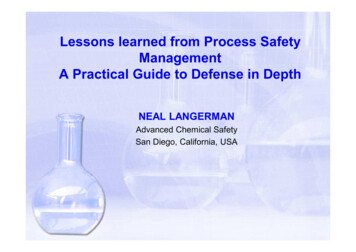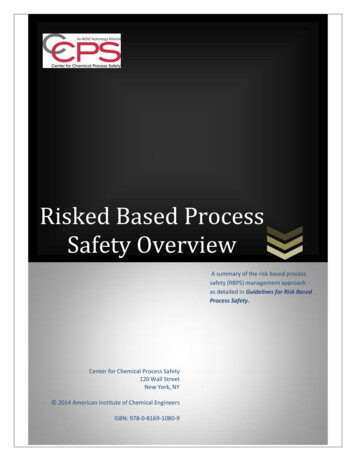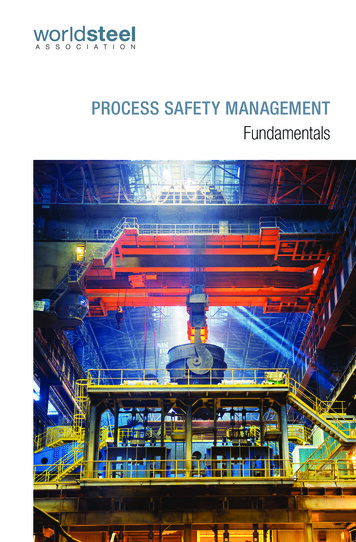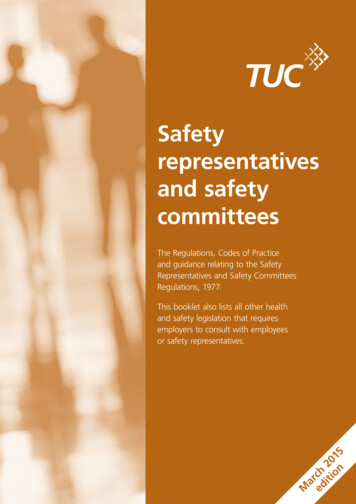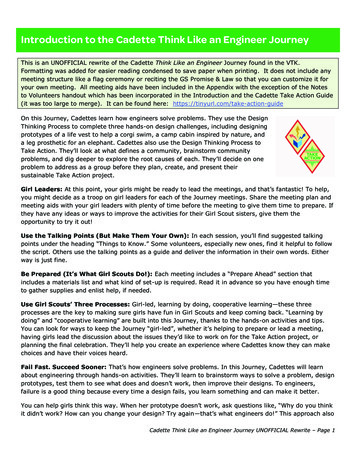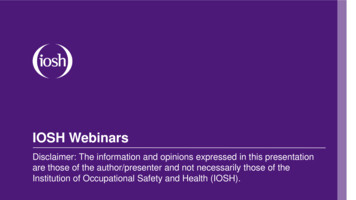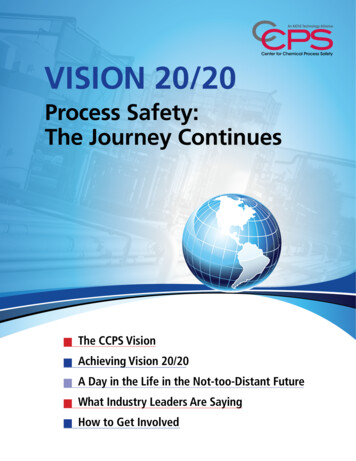
Transcription
Vision 20/20Process Safety:The Journey ContinuesThe CCPS VisionAchieving Vision 20/20A Day in the Life in the Not-too-Distant FutureWhat Industry Leaders Are SayingHow to Get Involved
A Guiding VisionBy the year 2020, leaders in process safety will value and demonstrate actionable commitment tothe competencies, communication, awareness and risk preparedness that prevent, minimize andmitigate process safety incidents.Vision 20/20, developed by the Center for Chemical Process Safety (CCPS), looks into thenot-too-distant future to describe how great process safety is delivered when it is collectivelyand fervently supported by industry, regulators, academia, and the community worldwide;driven by the five industry tenets; and enhanced by the four global societal themes.Five Tenets for IndustryAt the heart of Vision 20/20 is adherence to five core principles that will helpindustry target and drive performance improvement and achievegreat process safety performance: Committed CultureVibrant Management SystemsDisciplined Adherence to StandardsIntentional Competency DevelopmentEnhanced Application and Sharing of Lessons LearnedFour Societal ThemesVision 20/20 is a call to action for all of society — our leaders, our governments; the public at large — to be passionate about protecting peopleand property and, to accept no less than stakeholder knowledge, responsiblecollaboration, harmonization of standards and meticulous verification inmatters of process safety. The Vision 20/20 bridge to that commitment is foundedin four societal themes: Enhanced Stakeholder KnowledgeResponsible CollaborationHarmonization of StandardsMeticulous VerificationThe 20/20 DifferenceWhat does great process safety look like? CCPS asked top executives to walk us though a typical dayin the life of a CEO, a Unit Manager and an Academic, and then imagine what that same day wouldlook like if all industries were guided by Vision 20/20 tenets. Look inside to see what they said.
See What Industry Leaders Are SayingHow will Vision 20/20 tenets drive great process safety in the year 20/20? CCPS interviewed seniorexecutives from ExxonMobil, DuPont, Celanese, Alon USA, The Weir Group and others and asked fortheir input. Look inside to review their comments.To Drive ImprovementAs manufacturing and oil/gas production become more complex, the need to drivecontinuous improvement in process safety — not just for industry, but for allstakeholders — becomes increasingly urgent.Vision 20/20 harnesses the collective expertise and best practices of theCenter for Chemical Process Safety to establish a global framework forgreat process safety, driven by industry tenets and global societalthemes that will achieve: Significant industry and plant incident reduction Consistent overlap of corporate and plant employees, to ensureenhanced process safety understanding and rigorous adherence tostandards and practices Persistent knowledge, culture, understanding and implementation,which will be utilized by executives, management, technicians,engineers, students, government and the public A worldwide vision, guided by CCPS — a leader in state-of-the-artprocess safety solutions — for managing process safety improvementsto fulfill Vision 20/20Join Us!Achieving great process safety is both a journey and goal. Become aCCPS member, if you are not one already, and be a part of the process safetyvigilance/development teams that will create the guidelines and engagement toolsto support Vision 20/20.For additional information or to become involved in the drive to Vision 20/20 Process SafetyExcellence, go to www.aiche.org/ccps/about/vision-2020.
Five Industry Tenets, One Vision, The Collective ChallengeThese five industry tenets, combined with afervor for great process safety, provide a powerfulframework for Vision 20/20’s success. Processsafety results will dramatically improve if acompany has:1. A Committed Culture in which the executivesare personally involved, managers and supervisorsdrive excellent execution every day, and all employeesmaintain a sense of vigilance and vulnerability.To create a committed culture, leadership musttangibly demonstrate a commitment to processsafety, from the senior executive team through itsline management, so that all employees embrace itand recognize that “it could happen here.”2. Vibrant Management Systems ingrainedthroughout the organization, which readily adapt tothe organization’s varying operations and risks. Forvibrant management systems to be effective, allemployees must have a clear understanding of theirrole in managing process safety and of the expectations of senior management. The management systemis documented, accessible, easily used, and definesexpectations and how operations are conducted at theworkplace. It promotes safety in design, operations,and maintenance.3. Disciplined Adherence to Standards fornew and existing equipment to minimize opportunitiesfor error in design, operation and maintenance. Whilenew construction may be the primary considerationwhen evaluating standards, ensuring that existingequipment meets company expectations can be evenmore important. Companies should have requirementsthat ensure aging equipment adheres to appropriatestandards, while working cooperatively with regulatorsand industry associations to make standards effectiveand efficient.4. Intentional Competency Development toensure that all employees who impact process safetyare fully capable of meeting the technical and behavioral requirements for their jobs. The bottom line: nomatter how good the culture or management systemis, or how well the company adheres to standards, ittakes highly competent employees to implement thosesystems or standards. And that requires intentionalcompetency development.5. Enhanced Application and Sharing ofLessons Learned, including a broad expectationand thirst for learning. To reduce incidents, employersand employees must enthusiastically support a culturethat is driven to learn from many sources, includingbenchmarking, near misses and incidents and jobsdone well. The ability to rapidly share lessons learnedand use those lessons to drive procedural or mechanical change across companies and industries is key toimproving process safety performance.
Four Societal Themes, One Vision, The Collective ChallengeWe’ve come a long way since Flixborough, Seveso andBhopal. Yet, in spite of industry’s continuing processsafety vigilance, catastrophic events still happen. Totransform process safety culture, industry and the publicneed to work together to improve.Vision 20/20 details how the five tenets of culture,management systems, standards, competency, andlessons learned are enhanced by the community’sinvolvement, and supported by these four societalthemes:1. Enhanced Stakeholder Knowledge forall parties, beginning with the public, and includinggovernment and industry leaders. The public mustengage in science, technology, engineering and mathematics (STEM) education, and push for risk literacyin high school, so that our students are prepared toabsorb more technical concepts in business andengineering schools. This also promotes meaningfultwo-way conversations with industry and the publicon process safety risks.2. Responsible Collaboration among regulatoryand investigative authorities, labor organizations,communities, research institutions, universities, andindustries, working together on a common goalof excellent process safety performance.3. Harmonization of Standards organizationsthat produce guidelines for the safe design, operationand maintenance of equipment, to streamlinepractices, eliminate redundancy and cooperativelyaddress emerging issues. Harmonization of Standardsleads to simplification and increased likelihood ofconformance to applicable standards in local, national,and global commerce.4. Meticulous Verification from knowledgeablethird parties, including public and non-governmentalorganizations, to help companies evaluate theirprocess safety programs. It will become standard practice for companies to supplement internal audits withcompetent third-party verification of their engineeredsystems and process safety management systems.
A Day in the LifeThe year 20/20 is not so very far away. Trying toimagine what a day in the life of a chemical, petroleum or biological executive, engineer or managermight be like, or how an academic can effect process safety improvement from the classroom andbeyond, can help determine how process safetyneeds to evolve in the coming years. Can youspot the core tenets and global themes that aredemonstrated in these Day in the Life scenarios?The CEO 2012On the ride in to the office in the back of her town car,the CEO reads through background information on thenearby production site she’ll be visiting later in theday. She makes a point of reviewing the productionnumbers and profitability, as well as the worker injuryrate. While the business numbers are below expectations, the site worker injury rate is better than the goal.In the office that morning, she asks the CFO for further analysis on the site financials. She also calls theregional Head of Health, Safety and Environment to seeif there’s been any change in the worker injury rate. Hereplies that those numbers are still good but that thesite has had a few process incidents lately.Around noon the CEO arrives at the site. While gathering with the site leadership team for lunch, she overhears some of the managers discussing a process upset incident that occurred overnight. Initially concerned,she relaxes when she hears that, although there was arelease of material, there were no injuries and the release was not reportable to public agencies. She commends the team on their good worker injury numbersand then delves into a discussion on production.Industry Tenet Key1. Committed Culture2. Vibrant Management Systems3. Disciplined Adherence to Standards4. Intentional Competency Development5. Enhanced Application and Sharing ofLessons LearnedDuring a tour of the units, she once again commendsthe control room workers for their worker injury rateand then casually chats with them about their ideas onproduction and operability improvements.The CEO 20/20The CEO sits back in her town car and pulls out hertablet to check the “daily KPIs,” as she does everymorning on the ride to the office. 1 Among the metrics,she notes that the production site she’ll be visitinglater that day has business numbers that are belowexpectations, but that the worker injury rate is doingwell. What draws her attention, though, is the steadyincrease in process upset incidents. Drilling downthrough the metrics, she sees that the site had yetanother overpressure incident the previous day. 2In the office that morning, she asks the CFO for furtheranalysis on the site financials. She also calls the regional Head of Process Safety to discuss the disturbingtrend in process upset incidents at the site. He repliesthat he’s seen the trend as well, and gives her somepoints to discuss during her visit. 1,1Arriving at the site and gathering with the site leadership team for lunch, the CEO launches into a discussion on the previous day’s incident and the trend ofprocess upsets. 1During a subsequent tour of the units, she commendsthe operators on their worker injury rate but also asksfor their thoughts about the process safety incidents.She makes a point to seek out some of the front-linesupervisors to chat about the importance of properconduct of operations and to gain their buy-in forimproving the process safety. 1, 5
A Day in the LifeThe Unit Manager 2012Arriving shortly before the overnight shift concludes,Andrew brings up the latest production numbers fromthe night shift on his monitor. He sees that for onceeverything seems to be operating smoothly. Smallupsets have caused production numbers to be belowtarget, so he’s happy to see a shift with no problems.Looks like he won’t have to visit the control room.He observes, however, that he still needs to act on theincident that occurred at the end of yesterday’s dayshift. With a few clicks of his mouse, he assigns it tohis engineer Cameron. He allows a small sigh of relief at least that’s done.Andrew begins the 0900 unit meeting with the usualreview of production and quality numbers. Followingthis, he asks Cameron if he saw that he’d been assigned the investigation lead. He follows with “Good,address it quickly.” Then going around the table, heasks each of his team if they have any issues; whenit’s Cameron’s turn, he begins to ask those presentabout potential safety and environmental impactsfrom the MOCs he has to coordinate. As some of theteam members begin to respond, Andrew interjects“Folks, this isn’t a safety review meeting. Schedule aseparate meeting.”At a site management lunch with the CEO, the plantmanager and plant safety manager approach Andrewand ask about yesterday’s incident. He observes theCEO eavesdropping on the conversation and makes itclear that it’s being investigated and that there were nosafety or environmental impacts.That afternoon, he smiles inwardly as the CEO compliments his unit on their worker injury numbers. Andrewhas made sure that his employees always wear PPEand take their time doing maintenance tasks and similar physical activities. Although he stresses over meeting production goals, he does emphasize worker safety.The Unit Manager 20/20Zach arrives at his unit at 0630 every morning. His firststop is always the control room to chat with the nightshift. 1 Looking at the shift log and chatting with hisoperators gives him a much better feel for what’s reallygoing on; it’s also allowed his operators to talk openlywith him about any issues. 1 He’s glad to hear that everything went smoothly last night; his production numbershave been below target; any shift without an upset is animprovement. He also asks the shift supervisor for anyinsight on yesterday’s overpressure incident. 5Arriving in his office, his first order of business is toassign his unit engineer James as the investigation leadfor yesterday’s incident. Zach observes that this is justone of several similar incidents; he decides he’s goingto keep close tabs on this investigation through theonline incident system. 2Zach starts the 0900 unit meeting with a safety moment about using a ladder at his home. 1 After gettinghis team into the right frame of mind, his first topic isthe incident. 1 He’s pleased that Neil already has scheduled the first investigation meeting and he passesalong the input from the night shift. Later, he’s pleasedthat James wants to address the MOCs right now in themeeting. Zach knows it won’t take too much more timebut these changes should smooth out some of theupsets; Zach readily supports the review at that time. 1During lunch with the CEO, Zach is a bit surprised tohear the CEO dive directly into a discussion on hisunit’s incidents. Nevertheless, he calmly contributesthat he’s similarly concerned about the repeat natureof the events, has received some insight from his nightshift, and is personally monitoring this investigation.As the CEO tours his unit, Zach stays in the backgroundas she chats with his operators. He’s impressed with herknowledge of process safety and her effort to emphasizeit, especially to the supervisors. 1 He’s sure her effortswill help improve process safety and production.Societal Theme Key1. Enhanced Stakeholder Knowledge2. Responsible Collaboration3. Harmonization of Standards4. Meticulous Verification
A Day in the LifeThe Unit Engineer 2012Terry sips his first cup of coffee and rereads the emailassigning him as investigation lead for the upset andpressure relief incident yesterday. He’s already thinking“Great, one more thing on the list. How am I going tofit an investigation into my schedule?”Diverting himself momentarily from the incident email,he turns to the two high-priority Management ofChange (MOC) forms he’s responsible for coordinating.Both changes are relatively simple and nearly identicalchanges have been made multiple times previously,but he still needs to make sure that the extensivechecklists are completed. He wonders if he can justcomplete them ahead of time “Do we really need todiscuss and answer all of those questions?”In addition, he’s the technical “expert” on a new by-passsystem that is being designed. He needs to approvethe design today; he feels the design is sound but hasbegun to wonder if it meets “codes.” The company hasinternal standards but they are rather dated and don’tapply to all situations. He hasn’t kept up on relevantexternal recognized codes and the company has neverpushed for him or others to learn those codes. Hethinks there’s an old copy of one of the codes in hisfiling cabinet. He decides he’ll worry about that in theafternoon; he has to find time for those MOCs.He has a unit meeting coming up at 9:00 a.m. andsighs, “Great, more time wasted.”Thinking back to the incident, he knows that this isjust one of several similar incidents the cause andfindings should be the same that should make theinvestigation simple and get it out of the way maybehe’ll just quickly meet with the operations supervisorsometime tomorrow.The Unit Engineer 20/20James grabs his first cup of coffee and rereads the emailassigning him as investigation lead for the upset andpressure relief incident yesterday. He quickly pulls up theincident “screening” methodology in the incident trackingsystem; the results show that because this was a repeat incident and had the potential to be “really bad” itrequires a comprehensive, systematic root cause analysisinstead of one of the more streamlined methods.2James thinks, “As if I don’t have enough to do. This isgoing to be more involved than I thought.”Nevertheless, he knows it has to be done right andbegins re-planning his day.1He turns to the two high-priority Management ofChange (MOC) forms he’s responsible for coordinating.He notes that the submitter attached an existing siteprocedure created specifically for these types of process changes. The site created this procedure becausethe changes are relatively simple and are performed afew times per year. The site still manages the changesunder MOC because there can be minor differencesfor each change. The site MOC “system,” however,has generated streamlined yet applicable safety andenvironmental review forms.2 He breathes a sigh ofrelief—the forms combined with the specific procedure will minimize the review time involved while stillforcing the MOC team to answer the right questions.He should be able to address both of these during the9:00 a.m. unit meeting.In addition, he’s the technical “expert” on a new by-passsystem that is being designed.4 He needs to confirmtoday that the design meets the recognized industrycodes.3 Having been to refresher training on the relevantcodes earlier in the year,4 he feels he can complete thattask after the unit meeting.Although James still has a lot to do, he realizes he cannow devote the afternoon to the incident investigation.He begins identifying investigation team members anddrafting an email instructing them to make their afternoonavailable—the investigation needs to be their priority.1Industry Tenet Key1. Committed Culture2. Vibrant Management Systems3. Disciplined Adherence to Standards4. Intentional Competency Development5. Enhanced Application and Sharing of Lessons Learned
A Day in the LifeThe Academic 2012Julia strides out of the faculty fitness center and headstowards the campus café. Her workout, combinedwith a good night’s sleep, has left her mind clear andrefreshed. It’s the first day of classes and she’ll needto be sharp — as an assistant professor at the university’s school of business, one of the top-rated schoolsin the nation, she’ll be facing an MBA class of aggressive “up-and-comers” who’ll be full of questions tryingto impress her and their classmates.An hour later, Julia coolly welcomes the students toher Integrated Business Analysis class. She reviews thesyllabus, spending a few minutes on each of the topics. She then asks for questions on the overall coursecontent. The first question catches her slightly off guard:“Is risk management limited to financial risk?” Huh? Ofcourse, what other kind of risk . Recovering, she replies:“Business risk focuses on financial effects; therefore, ourfocus is on financial risk.” As she fields other questions,something gnaws at the back of her mind.Serendipity strikes that afternoon when her department head stops by her office and informs her that thechemical engineering department has requested thebusiness school help prepare a lecture on risk management for the process safety element in their designcourse. He’s assigning that task to her. Her momentaryannoyance fades as that gnawing in her mind returnswith a vengeance.That evening, she spends a couple hours at the monthly meeting of the local chapter of a major outdoorconservancy organization. Being an avid outdoors person, she’s passionate about preserving nature’s beauty.Her mind wanders a bit as the officers plod throughthe standing business items but snaps back when thepresident mentions the meeting’s main topic: “risk”from a local chemical facility. There’s that word again The Academic 20/20Julia strides down the hall towards her first class of thenew semester. As a senior faculty member in one of thenation’s premier business schools, she’s been entrustedwith one of the most important classes in the MBA program. She knows she’ll be peppered with questions butshe also knows she’ll be broadening her students’ visionof what makes a successful business leader.Walking purposefully into the classroom, she casuallyannounces “Welcome to Business Risk Management:An Integrated Approach.” 1 Fifty minutes later, sheconcludes forcefully with “As future business leaders,you’ll be confronted with a myriad of risks. Your jobwill be to manage that risk — all of it. If you focus juston financial risk, at best you will limit your success,at worst you will fail miserably. Apply the principleslearned in this course and you will be prepared tomake risk decisions competently; ignore these principles not only at your own peril but at the peril of thelives and well-being of your co-workers, neighbors,friends and family.”After class, Julia drives to a local high school to delivera required “Introduction to Risk Concepts”secondary education lecture to the sophomore chemistry class. 1 Risk management has become her passion,propelling her academic career to unforeseen heights.She knows that improving risk literacy among studentsultimately promotes more effective risk managementfor society as a whole. She considers it an honor and aduty to be today’s “guest teacher.”She spends her evening preparing for an upcoming “verification” of the process safety managementsystems at a local chemical facility. 4 She representsthe local chapter of a major conservancy group on thecommunity “verification team.” As she reviews thelatest online facility data, 5,2 casually noting anincident just the day before, she ponders the uniqueconnection to her own life: much of her essentialoutdoor equipment is made with products producedby that facility. 1Societal Theme Key1. Enhanced Stakeholder Knowledge2. Responsible Collaboration3. Harmonization of Standards4. Meticulous Verification
See What Industry Leaders Are Saying About Vision 20/20 TenetsOn Committed Culture“To be successful at both sides of safety requires a workforcethat truly believes that all accidents are preventable . It’s gotto be in the heads and hearts of people, if you’re going toperform well in process safety.”— Stephen Pryor, ExxonMobil Chemical“If your plant sites and your businesses see [PSM] as animportant aspect of what [you] value, then they will take thatand make it their values as well and will operate with thehighest standards of PSM.”— Ellen Kullman, DuPont“My advice and guidance to any CEO [is] if you don’t demonstrate the leadership in driving process safety and personnelsafety in other aspects of your business, it is not going tohappen — or it is not going to be sustainable.”— James Alder, CelaneseOn Vibrant Management Systems“You can’t look at this as a regulatory effort, you can’t lookat it as a cost center. I look first of all, to ensure that we aredoing the right things for the employees the community theshareholders and the board. Through the proper implementation of the process safety system, we’re providing a disciplineto the organization. It’s going to ensure that we have a betterrun organization better reliability, fewer accidents, fewer problems, fewer environmental problems there are just all kindsof benefits to doing this.”— Paul Eisman, Alon USA“Committed leadership is not enough, clear policies are notenough, you need a management system to ensure that thosepolicies and that leadership commitment are translated intospecific activities, specific measurements, and that the systemis robust and ongoing.”— Stephen Pryor, ExxonMobil ChemicalOn Disciplined Adherence to Standards“The one thing that has to be constant is our adherence toPSM, our discipline around that, because that is really whatgives us the confidence to operate these kinds of facilities,day in day out, in our communities around the world .There’s not a choice in my mind. If you’re going to operate safely, if you’re going to operate with the consent of thecommunities in which we operate, you need to do it with thehighest regard to process safety management.”— Ellen Kullman, DuPontOn Intentional Competency Development“Process safety is not something for the leader and the safetyexperts to know; everybody in the workforce has to becomemore and more knowledgeable about understanding what therisks are, helping us to identify risks, and making sure thatthey understand and execute all of our procedures properlyand consistently to avoid those risks.”— Stephen Pryor, ExxonMobil Chemical“To be an effective champion for process safety you need twothings: you need some appreciation for the technical detailsand the complexity of the function, and then you need asustainable, emotional commitment to prevent people fromgetting hurt.”— James Alder, CelaneseOn Enhanced Applications of LessonsLearned“A critical element of process safety excellence is a learningorganization. That means we learn at the site from every individual incident, and the front-line people have to understand,really understand, the higher potential consequence . Forthose higher potential consequences, we share those learnings worldwide. It’s not just sharing internally; it’s also sharingthose learnings with the industry.”— Stephen Pryor, ExxonMobil Chemical“I think one of the biggest issues that we face is that peoplebecome immune to the risks that are around them. There arevery serious risks when you go in from the outside, you cansee them—they’re there; they are pretty obvious, but peopletolerate them, because they become used to them.”— John Mogford, The Weir Group
Five Company Tenets and Four Societal ThemesEnhanced StakeholderKnowledgeVibrant ManagementSystemsEnhanced Applicationof Lessons ionCommitted CultureDisciplined Adherenceto Standardsal Tie tI n d u s t r y Te n e t shemesIntentional CompetencyDevelopmentocSHarmonization of GlobalStandardsVision 20/20, developed by the Center for Chemical Process Safety (CCPS),looks into the not-too-distant future to describe how great process safety isdelivered when it is collectively and fervently supported by industry, regulators, academia, and the community worldwide; driven by the five industrytenets; and enhanced by the four global societal themes.
AcknowledgementsThanks to:Cheryl Grounds, BP (chair)Jack McCavit, CCPSJoe Allaben, Koch Industries, Inc.Steve Arendt, ABS ConsultingTodd Aukerman, LANXESS CorporationScott Berger, CCPSMichael P. Broadribb, BakerRiskJeff Fox, Dow CorningWalt Frank, AIChEDave Jones, Chevron Energy Technology CompanyPete Lodal, Eastman Chemical CompanyLouisa A. Nara, CCPSSamantha Scruggs, BPKaren Tancredi, DuPont CompanyCenter For Chemical Process SafetyAn AIChE Technology Alliance120 Wall Street, 23rd Floor, New York, NY 10005 USATel: ( 1) 646.495.1371 Fax ( 1) 646.495.1504www.ccpsonline.org e-mail: ccps@aiche.org 2014 AIChE 8403a 08.14
ship team for lunch, the CEO launches into a discus-sion on the previous day's incident and the trend of process upsets.1 During a subsequent tour of the units, she commends the operators on their worker injury rate but also asks for their thoughts about the process safety incidents. She makes a point to seek out some of the front-line




